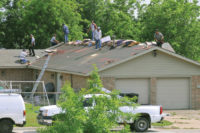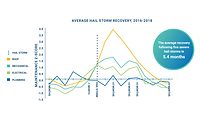Surviving the Slump




Coming out of one of the coldest winters in recent history, the restoration industry has benefited from the abundance of frozen pipe and ice-dam claims. In the wake of this season’s wrath, it is hard to imagine there are still areas of the country where claims are down and contractors are struggling to get work. Yet, in areas like Northern California, the Rocky Mountain Region and Florida, lack of work is the reality for some. This poses the question: is the shortage of work regional, seasonal or just isolated to specific companies having a run of back luck?
In baseball, this phenomenon is called a slump. It can sneak up on a hitter without warning at any time. Today the batter goes 3-for-4 with a homer and four RBIs. Before you know it, he is “0” for an eternity and couldn’t buy a hit if he tried. It is a paralyzing condition that can make a baseball look like a dancing pea being hurled at 90+ miles per hour. The slump causes hitters to question everything they do, from the mechanics of their swing to their pitch selection, the type of bat they use, what they eat for breakfast, even the pair of socks they wear. Every hitter fears the slump, and none are immune.
In the restoration industry, we can look at a graph of any company’s sales history by month over an extended period of time and see the slump present here as well. One month the phone is ringing off the hook and restorers are signing up several jobs per day. The next they couldn’t get a job if they offered their services for free. The slump causes them to question everything they do, from the effectiveness of their sales and marketing to the quality of their estimating, their participation in vendor programs, the route they drive to work each morning, even the color of shirt they wear. Every seasoned restorer has experienced the slump. They know it is eminent, and as in baseball, none are immune.
Despite the daunting circumstances that surround this inevitable epidemic, some companies have developed a knack for minimizing its ill effects and shortening its duration. Just as how the great hitters in baseball prepare themselves both physically and mentally, great restoration companies must do the same. Knowing the slump will eventually happen, the best they can do is to minimize its effects and reoccurrences. Using world-renown sports leadership expert Jeff Janssen’s four-step method of busting the slump, we will explore the ways restoration contractors can overcome the dry seasons.
Find the REAL cause of the slump
If we perform a root cause analysis on companies that experience the slump frequently, what we find more often than not is that all the leading indicators point to seasonality and a lack of referral sources. The laws of economics state that sales are driven by demand. In the restoration industry, that means property damage. Extreme weather events and mechanical failures are the two leading perils that create the demand for damage restoration services. Since restorers cannot create these scenarios themselves, they must create demand by diversifying both the services they offer and the sources from which they get their work.
This theory does not suggest that contractors should try to be everything to everyone. Rather, it represents opportunities to vertically integrate revenue streams that tap the core resources and skills already used in many restoration companies. Services such as plumbing, equipment rental, janitorial maintenance and contract commercial cleaning services are all common offerings of companies who have more steady revenue trends than those who are strictly mitigation and repair.
Providing diversified services automatically gives contractors a new pool of referral sources into which they can tap. However, this alone should not take the place of a solid sales and marketing plan to target key referral sources in the traditional insurance-related markets. The increasing control that third party administrators and preferred vendor programs have on the volume of property claims provides contractors with significant opportunities. This volume can pose significant risk if they represent a majority of the contractor’s business. Successful contractors use a balanced approach in developing referral sources by marketing to the complete spectrum of targets on the insurance side, including but not limited to agents, brokers, adjusters and risk managers.
Work smarter NOT harder
Nothing increases efficiency in the restoration business like a good weather catastrophe. The average cycle time of projects shrinks and profits soar. What normally takes workers eight hours to complete magically gets accomplished in four. This phenomenon occurs frequently and is often confused with hard work. In reality, surges of business force production to become more efficient by minimizing downtime, eliminating unproductive activities and increasing skilled productivity rates. If companies can perform this efficiently during a surge, they should be performing this way every day!
As efficiency and productivity rates increase, so does capacity. One of the more perplexing situations facing operations managers in the restoration field is maintaining appropriate levels of staffing. With the ebb and flow of business, this can be a real challenge. Restorers can overcome this issue by creating a scalable workforce through the use of temporary and part-time employees as well as strategic partnerships with other service companies. This lowers the burden to the business and provides options for the various types of skillsets required.
In an effort to fill production schedules when there aren’t any weather catastrophes, service businesses will often discount pricing. As tempting as it is to create demand by placing the services “on sale,” we need to understand this retail strategy is not an effective long-term solution for service businesses. This action results in price degradation and commoditization of the services offered because the “sale” price quickly becomes the going market rate.
Focus on the process, NOT the outcome
If contractors use good discipline in business, landing new work is not much different than hitting a baseball. Consistently keeping your head down, your weight back and your swing level will result in more hits than any other strategy alone. In business, this means making every sales call count and running every job profitably, especially when work is abundant and everyone is busy. Lack of discipline leads to complacency and bad habits. Focusing on the process forces everyone to maintain good discipline in all areas, from business development to operations.
The same remains true for accounting, specifically cash management. Disciplined businesses employ what is considered the “Homemaker’s Theory of Economics.” They don’t spend it unless they have it, and they dog the money like they are broke. Much like keeping your head down and your weight back, this very simple financial philosophy will position any sized company to not just survive the slump but actually prosper while the competition is suffering.
Stop thinking and start swinging
When businesses slump, we often find owners and managers who bury their heads in reports, combing through numbers and percentages, looking for answers, sometimes without knowing the questions. The cliché “paralysis by analysis” is very fitting. It is problem-focused and leads to a plethora of excuses. Once the problems are identified, stop searching and start solving.
As a consultant who specializes in operations management, I love reports just as much as the next guy. However, if some business owners spent half as much time making sales calls as they did trying to figure out why Xactimate made a half percent change in the drywall price, the situation would be much different. You can’t get a hit unless you swing the bat. Pick up the phone and ask someone for work!
Don’t wait until you can’t make your next payroll to use these slump-busting strategies. These four simple steps provide the fundamentals for a positive environment that attracts and motivates quality employees. The renewed sense of urgency will have a more lasting impact than any weather event or fancy marketing campaign. When reinforced each and every day, the results are undeniable. The search for stability and growth can be found in the fundamentals. They are always present and never change.
Looking for a reprint of this article?
From high-res PDFs to custom plaques, order your copy today!








